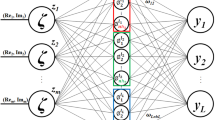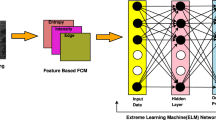Abstract
In this paper, multispectral image segmentation using a rough neural network based on an annealed strategy with a cooling schedule is created. The main purpose is to embed an annealed cooling schedule into the rough neural network to construct a segmentation system named annealed rough neural net (ARNN). The classification system is a paradigm for the implementation of annealed reasoning and rough systems in neural network architecture. Instead of all the information in the image are fed into the neural network, the upper- and lower-bound gray level, captured from a training vector in a multispectral image, were fed into a rough neuron in the ARNN. Therefore, only 2-channel images are selected as the training samples if an N-dimensional multispectral image was used. In the simulation results, the proposed network not only reduces the consuming time but also reserves the classification performance.



Similar content being viewed by others

References
Vannier M, Pilgram T, Speidel C, Neumann L, Rickman D, Schertz L (1991) Validation of magnetic resonance imaging (MRI) multispectral tissue classification. Comp Med Imaging Graph 15:217–228
Bhandarkar SM, Nammalwar P (2001) Segmentation of multispectral MR images using a hierarchical self-organizing map. In: 14th IEEE symposium on computer-based medical systems, pp 294–299
Li P, Hu H (2007) Segmentation of high-resolution multispectral image based on extended morphological profiles. In: IEEE International conference on geoscience and remote sensing symposium, pp 1481–1484
Hasanzadeh M, Kasaei S (2010) A multispectral image segmentation method using size-weighted fuzzy clustering and membership connectedness. IEEE Transaction on geoscience and remote sensing letters, pp 520–524
Roula MA, Bouridane A, Kurugollu F, Amira A (2002) Unsupervised segmentation of multispectral images using edge progression and cost function. In: International conference on image processing, vol 3, pp 781–784
Pal SK, Mitra P (2002) Multispectral image segmentation using the rough-set-initialized EM algorithm. IEEE TRANS Geosci Remote Sens 40:2495–2501
Li P, Xiao X (2004) Evaluation of multiscale morphological segmentation of multispectral imagery for land cover classification. In: IEEE International symposium on geoscience and remote sensing, vol 4, pp 2676–2679
Pan J, Li M (2003) Segmentation of MR osteosarcoma images. In: Fifth International conference on computational intelligence and multimedia applications, pp 379–384
Hasanzadeh M, Kasaei S (2010) A multispectral image segmentation method using size-weighted fuzzy clustering and membership connectedness. IEEE Geosci Remote Sens Lett 7:520–524
Pawlak Z (1982) Rough sets. Int J Inf Comput Sci 11:145–172
Pawlak Z (1984) Rough classification. Int J Man-Mach Stud 20:469–483
Dubois D, Prade H (1990) Rough fuzzy sets and fuzzy rough sets. Int J Gen Syst 17:191–209
Klir GS, Yuan B (1995) Fuzzy sets and fuzzy logic—theory and applications. Prentice-Hall, Englewood Cliffs
Liu J, Hao X (2009) Upper approximation fuzzy rough communication model at a threshold value. In: International conference on artificial intelligence and computational intelligence, pp 78–82
Zhang Y, Wang L, Wang J (2006) Application of rough set algorithm based on fuzzy clustering in flotation process system. In: Proceedings of the 6th world congress on intelligent control and automation, pp 5887–5891
Sarkar M, Yegnanarayana B (1998) Fuzzy-rough membership functions. In: IEEE International conference on systems man, and cybernetics, pp 2028–2033
Luo J-X, Shao H–H (2003) A neurofuzzy system based on rough set theory and genetic algorithms. Int Conf Mach Learn Cybern 2:1147–1152
Hu Y, Jiang X, Xin F, Zhang T, Yuan J, Zhai1 L, Guo C (2008) An algorithm on processing medical image based on rough-set and genetic algorithm. In: Proceedings of the 5th International conference on information technology and application in biomedicine, in conjunction with the 2nd International symposium and summer school on biomedical and health engineering, pp 109–111
He M (2008) Feature selection based on ant colony optimization and rough set theory. In: International symposium on computer science and computational technology, pp 247–250
Li C, Zhang H, Wang J, Zhao R (2006) A new pattern recognition model based on heuristic SOM network and rough set theory. In: IEEE International conference on vehicular electronics and safety, pp 45–48
Hassan Y, Tazaki E, Egawa S, Suyama K (2002) Rough neural classifier system. In: IEEE International conference on systems, man and cybernetics, vol 5
Ang KK, Quek C (2006) Rough set-based neuro-fuzzy system. In: International joint conference on neural networks, Vancouver, BC, Canada, pp 742–749
Zhou T, Deng F, Lu H, Zhao W, Yang F (2006) Temporal rough neural network. In: 5th IEEE International conference on cognitive informatics, pp 749–753
Li M-X, Wu C-D, Jin F (2006) A vision-based inspection system using fuzzy rough neural network method. In: Proceedings of the fifth International conference on machine learning and cybernetics, pp 3228–3232
Chen T, Luo J, Shen B (2007) Research on rough set-neural network and its application in radar signal recognition. In: 8th International conference on electronic measurement and instruments, pp 3-764–3-768
Lingras P (1998) Comparison of neofuzzy and rough neural networks. Inf Sci 110:207–215
Metropolis N, Rosenbluth AW, Rosenbluth MN, Teller AH, Teller E (1953) Equations of state calculations by fast computing machines. J Chem Phys 21:1087–1092
Kirkpatrick S Jr, Gelatt CD, Vecchi MP (1983) Optimization by simulated annealing. Science 220:671–680
Lin J-S (1999) Image vector quantization using an annealed Hopfield neural network. Opt Eng 38:599–604
Tan HL, Gelfand SB, Delp EJ (1992) A cost minimization approach to edge detection using simulating annealing. IEEE Trans PAMI 14(1):3–18
Van Laarhoven PJM, Aarts EHL (1987) Simulated annealing: theory and application. D. Reidel Publishing Company, Dordrecht
Ruspini E (1970) Numerical methods for fuzzy clustering. Inf Sci 2:319–350
Lin JS (2001) Annealed chaotic neural network with nonlinear self-feedback and its application to clustering problem. Pattern Recognit 34:1093–1104
Chen L, Aihara K (1995) Chaotic simulated annealing by a neural network model with transient chaos. Neural Netw 8:915–930
Acknowledgments
This work was supported by the National Science Council, TAIWAN, under the Grants NSC98-2221-E-167-016-MY2.
Author information
Authors and Affiliations
Corresponding author
Rights and permissions
About this article
Cite this article
Chang, YY., Tai, SC. & Lin, JS. Segmentation of multispectral MR images through an annealed rough neural network. Neural Comput & Applic 21, 911–919 (2012). https://doi.org/10.1007/s00521-011-0724-1
Received:
Accepted:
Published:
Issue Date:
DOI: https://doi.org/10.1007/s00521-011-0724-1



